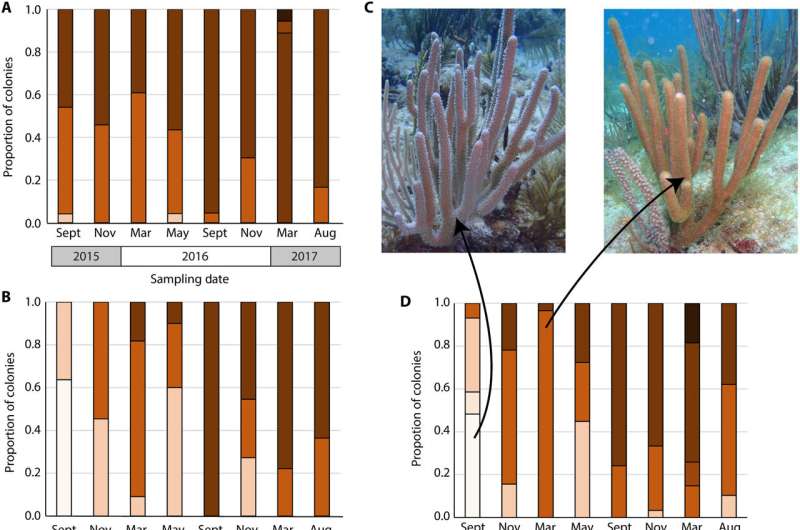This article has been reviewed according to Science X's editorial process and policies. Editors have highlighted the following attributes while ensuring the content's credibility:
fact-checked
peer-reviewed publication
trusted source
proofread
Study identifies key algae species helping soft corals survive warming oceans

Scleractinian corals, or hard corals, have been disappearing globally over the past four decades, a result of climate change, pollution, unsustainable coastal development and overfishing. However, some Caribbean octocorals, or soft corals, are not meeting the same fate.
During a two-year survey of soft corals in the Florida Keys, Mary Alice Coffroth, professor emerita of geology at the University at Buffalo, along with a small team of UB researchers, identified three species of octocorals that have survived heat waves. While the coral animal itself may be heat tolerant, Coffroth said that her team concluded that the symbiotic algae inside the coral serve as a protector of sorts.
"The resistance and resilience of Caribbean octocorals offers clues for the future of coral reefs," Coffroth said.
A recent paper outlining their research, "What makes a winner? Symbiont and host dynamics determine Caribbean octocoral resilience to bleaching," was published on Nov. 22 in Science Advances.
Coffroth is the lead author on the study she conducted between 2015 and 2017 with graduate student Louis Buccella, undergraduates Katherine Eaton and Alyssa Gooding and technician Harleena Franklin. Howard Lasker, professor emeritus in the departments of Environment and Sustainability and Geology, also contributed to the study.
Algae helps corals survive heat waves
Both hard and soft coral depend on a nutritional symbiosis with single-celled algae living within their tissues. Warmer waters can cause the symbiosis to break down, resulting in a loss of the algal symbionts, which turns the corals white, a phenomenon known as bleaching.
"Bleaching can lead to coral death," said Coffroth, who has studied coral reefs in the Florida Keys since 1998, including a more recent study in 2020–21. "It's unclear if the algae leave or are ejected from the coral.
"In this study, we examined possible mechanisms that contribute to the heightened resistance and resilience of three octocoral species in the face of the recurring marine heat waves leading to bleaching events," Coffroth said, noting that this is the first study that follows both symbiont genetic makeup and density in Caribbean octocorals before, during and after a major heat wave.
By and large, Caribbean octocorals harbor symbionts within the genus Breviolum, she said. And this symbiont is helping to make the octocoral better able to handle the rising heat.
"The Breviolum densities declined during the heat waves but recovered quickly," she explained. "Octocoral mortality was low compared to their scleractinian relatives."
2014 El Niño prompted research
When Coffroth saw bleached corals during the 2014 El Niño and knew that a similar event was predicted for the following summer, she applied for a Rapid Response Research (RAPID) grant from the National Science Foundation. She was awarded $56,305 and with her master's student, Buccella, conducted the study in the Keys, following the fate of the octocorals and their symbionts for 28 months.
She and other members of the team made trips to the Keys Marine Lab at the Florida Institute of Oceanography to study the octocorals in the spring and fall of 2015 and 2016 and spring and summer of 2017, recording coral coloration and taking samples to study density of the symbionts and their genetic identity.
"We knew it was critical to follow individual colonies across an event with long-term monitoring of both host and symbiont responses," she said, "and to examine the response at least at the level of symbiont species, if not the genotype, to identify potentially resilient species."
Climate change moving faster than coral evolution
Although the study began almost a decade ago, Coffroth said the findings are extremely relevant because they mirror what is happening right now, with the continuing warming of ocean waters, increased storms and major bleaching events across the globe.
"There is evidence that corals are withstanding higher temperatures now than they did in the 1960s," she said. "That signals evolution, but the problem is that climate change is moving too fast, faster than evolution."
In addition to their beautiful aesthetics, coral reefs provide many benefits to the planet and its inhabitants, including barriers to coastal regions that are susceptible to hurricanes and other tropical storms; habitat for large fish such as grouper and snapper; a tourist destination for snorkeling, fishing and diving; and a source for bioactive compounds used in drugs to treat inflammation and certain kinds of cancer.
"If you a see picture of coral reefs when I started diving in the 1970s and compare it with one now, it makes you want to cry," she said. "The change is just amazing."
While she noted that this study has some important observations, further study is needed to better understand what is happening to the ecosystem.
"I'm seeing species bleach that have never bleached before but also ones showing more resilience," she said. "There is a lot of variation within both the animal and symbiont genera. We need to understand the variation."
The hope is to continue research into coral reef relationships and the durability of the symbiotic algae while also taking steps to halt the damage to the environment by human action, such as overfishing and the burning of fossil fuels.
"We can't stop global warming," Coffroth said. "But the hope is that we can slow it down."
More information: Mary Alice Coffroth et al, What makes a winner? Symbiont and host dynamics determine Caribbean octocoral resilience to bleaching, Science Advances (2023). DOI: 10.1126/sciadv.adj6788
Journal information: Science Advances
Provided by University at Buffalo


















